Instructions:
1) Be sure to have the correct tools and supplies for for the job. If you do not have them, get them. You will need a regular size Phillips screwdriver, a smaller size Phillips screwdriver, needlenose pliers, wire cutters or other flush cut nippers, a hobby knife such as an X-Acto, scissors, a soldering iron, solder, electrical insulating tape, and a black Sharpie permanent ink marking pen. If you intend to mount the DIN jack on the back panel with the rest of the jacks (highly recommended), you will need to use a chassis punch (a small hand tool that safely cuts a clean hole in a metal panel) to make the hole for the DIN jack, and an electric drill with a 1/8" or similar size drill bit to drill holes for the 4-40 hardware used to mount the DIN jack, and also a 1/4" or 5/16" drill bit to make a pilot hole to start the chassis punch. The correct size for mounting a MIDI DIN jack is 14.5 mm metric or 5/8" SAE (.62"/15.9 mm) in American sizes. A chassis punch may be purchased from any good tool or hardware store. If it is more convenient, a punch may be mail ordered via internet or telephone from Mouser Electronics at http://www.mouser.com or (800) 346-6873. The Mouser part number is 586-3803 for the name-brand Greenlee 730-5/8 (about $30). The cheaper house brand part number is 380-0145 (less than $20). The service from Mouser is unpredictable and the house brand ordered by Synhouse for the test installation took three months to be delivered, while the Greenlee part was delivered in one week. Mouser refused to give even a small discount to customers of Synhouse, so no recommendation is deserved or being made here, and any other source you know of to buy this type of tool is highly recommended and certainly a better place to buy from for all of your needs now and in the future. You will also need an 11 mm wrench (for Greenlee) or 1/2" wrench (for the Mouser house brand punch) or adjustable wrench to turn the chassis punch while cutting the hole. An automatic center punch would also be useful. This is an inexpensive spring-loaded pointed punch that can mark your drilling spot without the use of a hammer. Marking the holes with this small indentation will allow you to drill cleanly without slipping and scratching the synthesizer or drilling through your knee.
2) Fully test the ARP Avatar to be converted to MIDI. Be sure that all functions such as the envelope generator work and that the instrument plays in tune while playing along with a known well-tuned instrument such as a newer digital synthesizer or sampler keyboard. If it doesn't work properly without MIDI, it certainly won't work with it.
3) Extreme caution should be taken while working on the ARP Avatar. The unit should be unplugged while open and even then, the power supply may pose some electric shock hazard due to residual voltage in the power supply.
4) Open the lid of the Avatar. It opens from the front edge without removing any hardware.
5) Turn the synthesizer upside down and shake out any dust and debris that may have accumulated inside the instrument over the years.
6) Determine the place where the
MIDIJACK circuit board will be mounted and test fit the board into its'
correct place inside the case. Be careful to avoid putting the board
or wires near the high voltage connections in the right rear of the instrument.
Mark the correct mounting holes on the panel with a pencil, marker,
or needle using the paper drilling template provided with the MIDIJACK
hardware packet as seen in this photo called ARP-pic1 which shows the paper
drilling template taped in place:
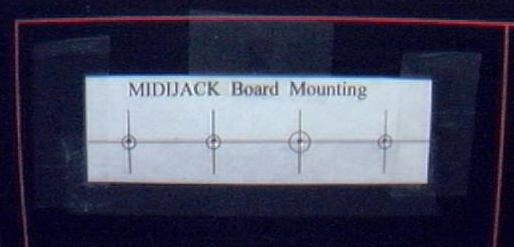
The perfect size drill bit for the switch
stem and two screw holes is 9/64", and the perfect size for the scale
adjust trimpot is 3/16". Drill the holes. A photo called ARP-pic2
shows the location of the newly cut mounting holes:
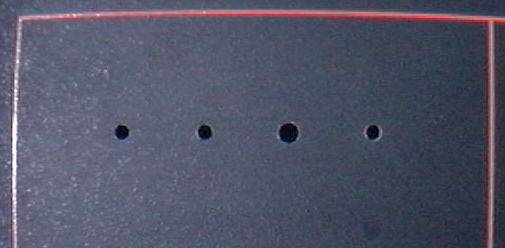
7) Mount the MIDIJACK board in place.
When mounting the MIDIJACK board, the switch should be fitted so
well in the panel that the switch stem will not wiggle at all once in place.
It should not have any free play but also should not be so tight that it
binds. When the switch is pressed, it should have a definitive
"click" and bounce back like the button on a new VCR. You will never
regret spending too much time on this and good attention to detail will
make the perfect MIDIJACK installation. The hole in the panel that
is over the MIDIJACK scale adjust trimpot should be large enough so a Synhouse
Pocket Screwdriver can fit through the panel for periodic adjustment.
The perfect MIDI control panel installation is shown in ARP-pic3:
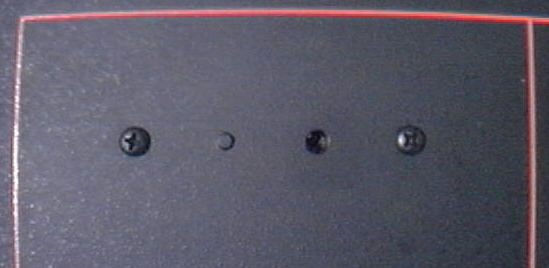
Such an installation will be nearly invisible, yet put the MIDI function button at the players' fingertips. For the serious Analog User and synthesizer collector, an ultra-clean installation pays off.
8) Determine the place that the MIDI
input DIN jack will be mounted. A good place to mount it is on the
back panel to the left of the CV IN jack, as photographed in this
example. To do this will require temporary removal of the circuit
board holding the 1/4" audio jacks. To avoid this effort, the
DIN jack could be mounted anywhere else on the instrument. There
is a lot of room on the rear panel of the Avatar, so you may mount
the DIN jack wherever it suits you best. The way to make this look
like original ARP factory equipment is to mount the DIN jack inside the
metal panel after marking the bare metal edges of the hole with a black
Sharpie permanent ink marking pen to match the black finish of the original
metal chassis. Use the paper template to mark the correct spots to
drill and cut as shown in ARP-pic4:
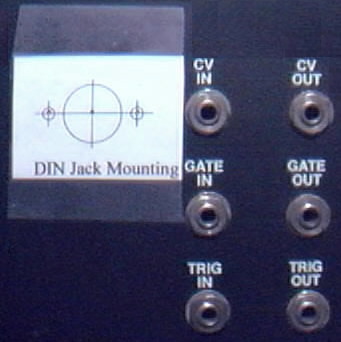
It is advisable to use a chassis punch
to make the hole for the DIN jack. Remember that the DIN jack is
to be mounted with the smaller 4-40 hardware size rather than the larger
6-32 size that secures the main board. Drill two holes for the screws
then drill a slightly larger hole in the center to act as a pilot hole
for the chassis punch. Use the chassis punch to cut the hole and
be sure that the wrench is turning the tool from inside the Avatar,
not outside, so the cutting edge is coming from the outside.
This will ensure that the outer edge is perfectly smooth. The properly
cut mounting holes may be seen in ARP-pic5:
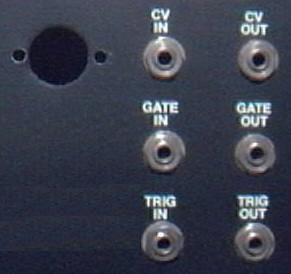
The MIDIJACK hardware packet contains both
long and short 4-40 screws for the DIN jack. Use the two long ones
for installation on a thick aluminum panel such as the Avatar. When
all three holes are perfect, put the DIN jack in place inside the
chassis and secure with the two screws from the outside, and the
four split washers and two 4-40 nuts on the inside against the back of
the DIN jack and tighten with a small Phillips screwdriver from the outside
and needlenose pliers from the inside. These nuts should be very
tight as they are going onto the metal surface of the DIN jack. By
using the Synhouse paper drilling template, a center punch to start
the drill, and a chassis punch, your DIN jack mounting can
look perfect like the one shown in ARP-pic6:
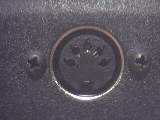
If done cleanly and correctly, the
Avatar will look like it had MIDI when it came from the factory,
as in ARP-pic7:
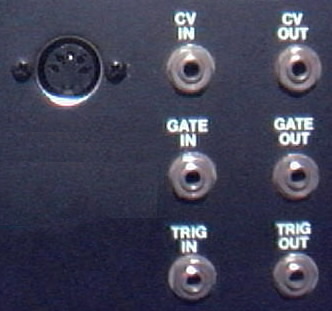
9) The wonderful thing about installing the MIDIJACK in an ARP Avatar is that all six necessary wiring connections can be made to the back of the existing analog interface jacks and a single circuit board in the Avatar (on the top side that is easily accessable) and the entire modification can be performed without removing any boards from the instrument. The Avatar has panel-mounted 1/8" jacks.
10) The MIDIJACK #1 black and #2
red wires must be soldered in place to get the ground and power for the
MIDIJACK. There is a ground terminal on each of the 1/8'' jacks which
connects to the sleeve of the jack, and none of them have factory
wires soldered to them because they are grounded directly to the chassis.
Solder the MIDIJACK #1 black wire to any one of the ground terminals,
such as the one shown in ARP-pic8, where the MIDIJACK #1 black wire
can be barely seen in the dark lower left corner:
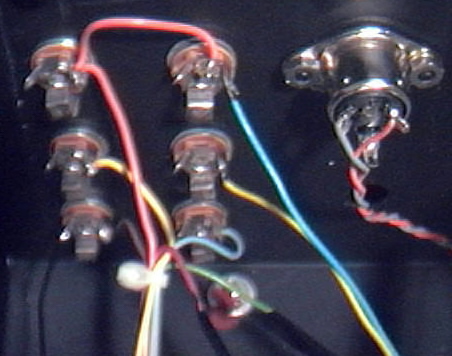
The correct regulated +15v power is available
on either of the two red wires coming from the power supply board at the
rear of the instrument. It may be most convenient to find a resistor
lead which connects directly to the red wires and solder the MIDIJACK #2
red wire to such a point, as shown in this example photographed in
ARP-pic9:
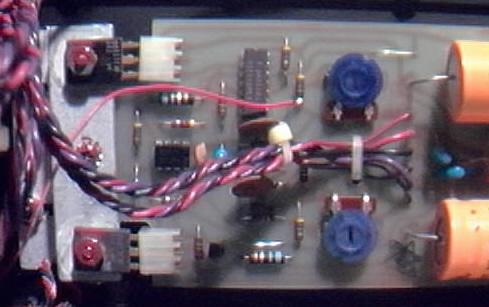
Solder the MIDIJACK #2 red wire to this point.
11) Locate the factory ARP red wire which is soldered to the right-hand terminal on the back of the CV IN jack. Remove the wire from the solder terminal by desoldering it. Solder the MIDIJACK #3 blue wire to the now-empty isolated CV terminal.
12) Solder the MIDIJACK #4 white wire to the now-disconnected factory ARP red wire. Carefully wrap the solder joint with electrical insulating tape.
13) Locate the factory ARP green wire which is soldered to the right-hand terminal on the back of the GATE IN jack. Remove the wire from the solder terminal by desoldering it. Solder the MIDIJACK #5 yellow wire to the now-empty isolated gate terminal.
14) Solder the MIDIJACK #6 green wire to the now-disconnected factory ARP green wire. Carefully wrap the solder joint with electrical insulating tape.
15) Photo ARP-pic8 shows the inside
of the rear of the jackpanel with the DIN jack mounted and the MIDIJACK
wires already connected to the proper points. A look at this will
give some idea of what it will look like when done correctly:

16) The MIDIJACK #7 brown wire and #8 violet wire (unless it is used for a special function as described in the Advanced Installation Manual) are not required for adding MIDI to the ARP Avatar, but it is a good idea not to permanently cut these wires off, as an alternate installation method may become useful later. It is best to wrap the ends of these unused wires with electrical insulating tape and bundle them with the other wires when finishing the installation.
17) The MIDIJACK hardware packet contains nylon cable ties which should be used to tie the MIDIJACK wires into little bundles and to attach them to the factory wires inside the Avatar now that all connections have been made. This will secure the MIDIJACK wires to the inside of the chassis so they will not rattle and break loose inside the case once the instrument is returned to service.
18) Carefully examine all soldered connections for possible short circuits before closing the instrument.
19) Close the instrument lid.
20) Test and calibrate using the procedures described in the Original MIDIJACK Quick Installation Manual.
21) This installation can be completed in 30 minutes.
Performance Tips:
The ARP Avatar
has a trigger circuit separate from the gate circuit to provide multiple
note envelope triggering. This is not required for MIDI operation
because the MIDIJACK has special software to do multiple note triggering
like an ARP or single note triggering like a Moog. The user can select
either mode at any time. For this reason, the Avatar guitar
pickups will still trigger the envelope generator even with the MIDI activated.
It is impossible to bypass the gate triggering completely so it is probably
a good idea not to play the Avatar guitar controller while MIDI is in use
or vice versa.
Copyright © 1/19/2001 Synhouse Multimedia
Corporation